Fitness counts to reach top in fast bowling
By A.C. de Silva
FLASHBACK... Bob Willis - the England pace bowler has said that he
should not be the model a youngster should follow if the bowler
concerned wants to beat a good batsman by sheer pace. Willis says that
he is well aware of the limitations. Willis says that he was aware of
the limitations when he was playing for England.
|
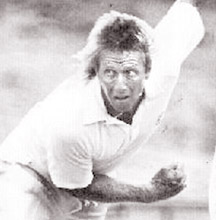
Jeff Thomson formed a fine combination with Lillee in
dumping England and West Indies. |
Willis says that his action usually put great strain on the groin,
ankles, the sides and the shoulders. He says that he is open-chested
when he delivers the ball. He has to rely on the shine or the seam for
the outswinger.
He says for some reason he was able to bowl fast. Willis who is 6
feet 5 inches in height enables him to get extra bounce. He says that
has come to appreciate the value of fitness. He says that he was lucky
that he was able to get some good advice over the years as he got older
and with some common sense and listening to some people he was able to
adjust himself.
Fast bowling is important and a look at the Test match figures for
nearly two decades. The decisive factor has almost always been fast
bowling take - for example the South Africans (Procter and Peter Pollock
against Australia in 1970), think of Snow for England against Australia
around 1971, then Lillee and Thomson rattling through England and West
Indies in successive years and what about the West Indies trio of
Roberts, Holding and Daniel in England in 1976? It is the fast bowler
who makes the decisive breakthrough in Tests, even more so when he has
to contend with a typical easy-paced wicket. He's the man his skipper
turns to when he's lost the toss and demands something special
counteract the disadvantage of batting second.
All-out attack
There's no respite when a fast bowler's operating at full throttle.
If he is quick enough he'll be desperately difficult to score from, and
with the new ball he can always come up with the unplayable delivery. It
is a war of attrition, and the mental strain on the Test batsman is
immense.
Willis says that he is often asked about the effect a quickie has on
the crowd: "yes", the crowd love to watch a genuine speedster really
rips it in.
When you are watching the play side-on from the boundary, it will be
possible to see the bowler pace out what seems an amazingly long run, he
comes tearing in, there's dust everywhere, and all the time the
wicket-keeper and slip are crouched. All the batsman has to defend
himself is a bat with which he had to defend himself-the crowd loves the
challenge thrown down by the genuine fast bowler.
|
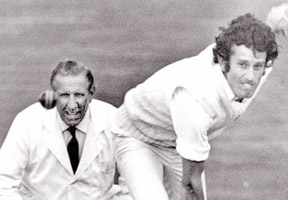
John Snow brings back memories of encounters with Australia in 1971. |
A fast bowler has a great responsibility to his team within the
framework of the modern game. And of the other qualities, the fast
bowler has got to be determined, optimistic, have a good memory and a
lot of guts. Bob Willis says that all the great fast bowlers in the game
during his time had those qualities. But the bowlers concerned have to
be really fast to get the wickets.
Vital propulsion
It's not a matter of sheer strength, looseness of limbs is more
important, and the final rotation of the hips to give the vital
propulsion which beings the bowling arm over fast.
If one takes his memory back to 1976 when West Indian Michael Holding
took 14 wickets at the Oval against England. Now that was a great piece
of bowling on a dead track. How did Holding get all those wickets? By
sheer speed through the air-never mind all the talk about seam and cut
and swing. Holding beat the bat by speed because his arm came over very
quickly.
So one has got to be natural to bowl fast. One thing the young fast
bowler needs is to be intelligent, farsighted advice that doesn't adhere
strictly to the coaching text-books and encouragement. Too many
youngsters are put off by harsh words that come from those who should be
encouraging them.
Willis says that it is very difficult to coach fast bowlers. Fast
bowlers really aren't manufactured, they are born. It doesn't matter how
keen the bowler is, natural ability is vital.
No short 'cut'
The first thing is to encourage a young fast bowler to do is to run
up in practice and bowl as fast as he can, if he's quick enough the
coach can build on that. So, if the young bowler has got natural speed,
the next thing - there's lot of hard work for a start - and more to
follow. There is no short cut, the bowler has to hammer away for many
hours at a spot to get that natural accuracy needed to survive in
top-class cricket. The bowler concerned must develop his bowling muscles
and the only way to develop them is in the nets, you can also do that in
the gym. Bob Willis says that it took him a long time to get himself
fit.
The fast bowler got to have that devel may care attitude, but though
he doesn't want to see the batsman badly injured, but he will have to
have the daring effect. It's a straightforward contest and the fittest
and strongest has a good chance of coming out on top.
|
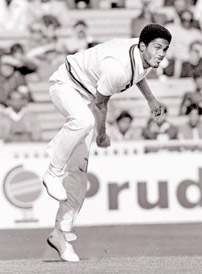
Michael Holding the West Indian terror a fine bowler to
trouble the batsman. He took 14 wickets at the Oval against
England that was a great piece of bowling. |
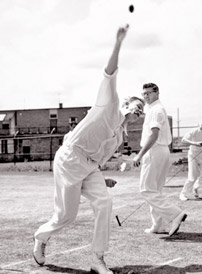
Peter Pollock ever willing to have a fling as did against
Australia in 1970.
|
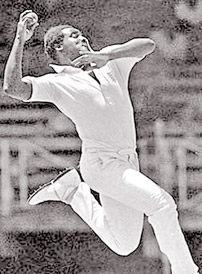
Wayne Daniel an useful support bowler along with Andy
Roberts and Michael Holding to put down the opponents.
|
|
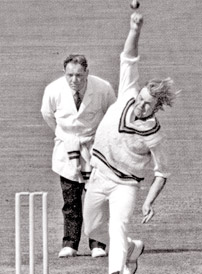
Mike Procter of South Africa ever willing to have a go at
the opponents batting.
|
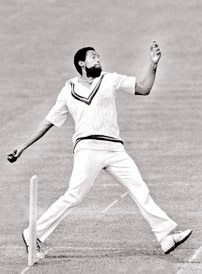
Andy Roberts of West Indies formed a fine three-cornered
combination brings back memories of what they did in England
in 1976. |
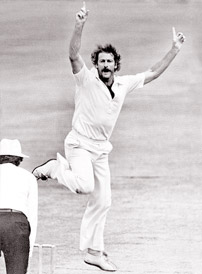
Dennis Lillee had the occasion to rattle through England and
West Indies.
|
|

